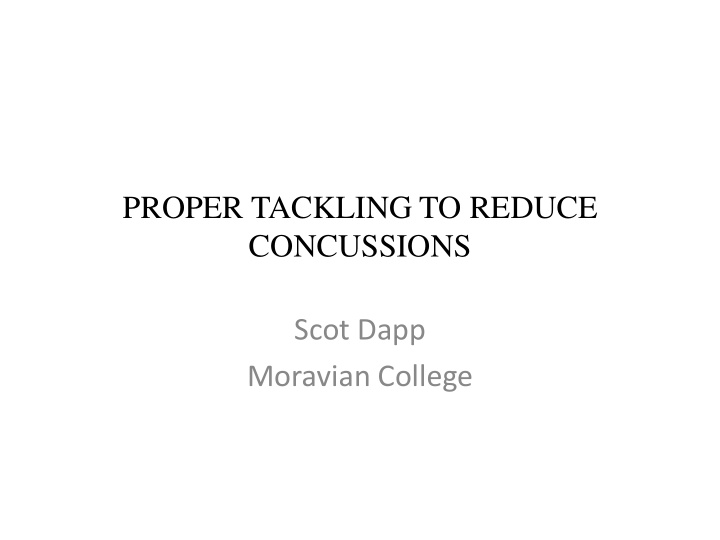



PROPER TACKLING TO REDUCE CONCUSSIONS Scot Dapp Moravian College
• Football is a collision sport • When the body is involved in a collision; injuries, including concussions can occur • The helmet was designed and first used to “protect” the head, especially the ears • “The leather football helmet has it’s origin more than100 years ago first worn in an 1893 Army-Navy game. An Annapolis shoemaker created the first helmet for Admiral Joseph Mason Reeves, who had been advised by a Navy doctor that he would be risking death or “instant insanity” if he took another kick to the head. Later in 1896 Lafayette College halfback George Barclay so feared the fabled cauliflower ear on his “hearing organs”, which he felt was a direct cause of playing bare-headed, that he had a playing hat made. His design was a special headgear which was held to his head by three heavy leather straps fashioned by a harness maker, thus giving the first football helmets the nomenclature “head - harness”.”
• The problem that developed was as the design of the helmet evolved to increase its protection of the head; it also became a weapon; the move to improve safety was also adding to the danger
• In the late 70’s, early ‘80’s, concerns began to rise with regards to head and neck injuries; “catastrophic injuries” • Tackling techniques came under scrutiny; particularly leading with the head – “spearing” • The NCAA began to add rules to lessen the possibility of these injuries; every year, the FB Rules Committee and the Competitive Safeguards Committee will discuss ways to improve the safety of the game • Bottom line: take the head out of the game – as a weapon AND as a target
• Proper tackling technique is a basic fundamental football skill that needs to be taught at every level: What is “tackling” • ”Tackling is grasping or encircling an opponent with a hand(s) or arm(s).” NCAA Football 2011 and 2012 Rules & Interpretations pg.39 • “…the tackler is taught to drive the shoulder into the opponent head on one side. The tackler should run or carry the opponent backward, throw him on his back, and fall directly on him.” Football by W. Glenn Killinger 1938 pg. 43 • “Above everything else in tackling, the eyes should be open. There is no place for a blind man on the football field” pg. 45
1 st Priority – start young
• Definition earlier included the word “arms” – there is a difference between “tackling” a ball carrier and “ramming” a ball carrier • The BIG hits often create excitement – ESPN highlights • Proper form when tackling can help reduce the possibility of a concussion occurring BUT not necessarily prevent it • What are the most dangerous situations that occur on the football field? • Many would immediately say the kickoff /kickoff return and certainly the speed of the game in those situations would lend to the possibility of injury (hence, recent NFL and NCAA legislation changing rules for the kickoff)
– WR vs DB going for thrown ball; especially if one or both leave their feet – BC (could include the QB) making a sudden and unexpected move: cutback; reverse direction – Two or more tacklers getting to the BC simultaneously – Initial hit on BC changes direction his body is moving and then is hit by a 2 nd defender • Common denominator: inability of the player to protect himself
• A tackler can control the position of his body (the head) when making contact – he cannot control how the BC may change the position of his body • “keep your head up” ‘bull your neck” “see your target” “eyes to the sky” • Lets look at a few still shots of some bad & good form for tackling
SUMMARY & QUESTIONS
Recommend
More recommend